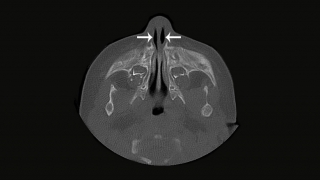Pyriform Aperture Stenosis
What is pyriform aperture stenosis?
Pyriform aperture stenosis (PAS) is a very rare birth defect where the front opening of the nose is narrow due to an overgrowth in the upper jaw bone. PAS is sometimes associated with other abnormalities, including the presence of a single central incisor tooth and pituitary abnormalities.
Pyriform aperture stenosis is present at birth and can be associated with other abnormalities. There is no known specific cause.
Signs and symptoms
Children with mild PAS will often be noisy but able to maintain their airway and feed appropriately. Children with severe PAS will often have significant distress, necessitating airway support and occasionally intubation. Symptoms include:
- Cyclic respiratory distress relieved with crying
- Noisy breathing
- Feeding difficulties
- Inability to pass a suction or scope into the anterior nasal passage (PAS)
- Nasal drainage
Testing and diagnosis
 CT scan demonstrating pyriform aperture stenosis
CT scan demonstrating pyriform aperture stenosis
Newborns with PAS often have difficulty moving air through their nose shortly after birth. Since infants breathe only through their nose until they are about 4 months old, they are unable to compensate by breathing through their mouths. The degree of respiratory distress depends on the degree of nasal narrowing. Feeding and weight gain are often impaired as well. Further evaluation is done with endoscopy and CT scans.
Aero-Digestive Evaluation
If your baby has PAS, she will need to be evaluated for both airway and feeding issues. Management of the airway often requires a combination of supportive, medical and surgical care. Feeding and swallowing issues are very common in children with these conditions and often need to be addressed by speech pathologists and GI specialists. Children born with syndromes often need other subspecialty evaluations (cardiology, ophthalmology, etc.) and benefit from the coordinated care provided in the multidisciplinary-setting of the Center for Pediatric Airway Disorders.
Treatments
Treatment depends on the severity of the anomaly (unilateral or bilateral), how much it affects the child's breathing and eating as well as what other medical conditions the patient has.
Treatment for mild cases
A child with a mild case of PAS case may not have respiratory distress or significant feeding issues. These patients may initially be managed with close observation and occasionally supplemental oxygen. Your doctor may also recommend using a nasal saline to keep the nasal linings healthy and free of discharge. Most often patients with mild PAS will improve over time with the growth of the airway.
Treatment for severe cases
Infants with severe PAS should have surgery as soon as they are stable and have been evaluated for other anomalies. The major goal of the surgical repair is to open the nasal airway sufficiently, allowing the infant to breathe through her nose without difficulty. There are several approaches available to accomplish this goal.
Surgical management of PAS is often performed using a sublabial approach, where an incision is made inside the upper lip where it meets the gums to access the bony openings into the nose. The encroaching bone is then removed using a curette or drill. Temporary stents are often necessary in order to maintain the repair site for a few weeks as the area heals. Once the openings are enlarged, the infant's breathing and feeding problems are resolved.
Further follow-up is only necessary if the child redevelops PAS symptoms.





